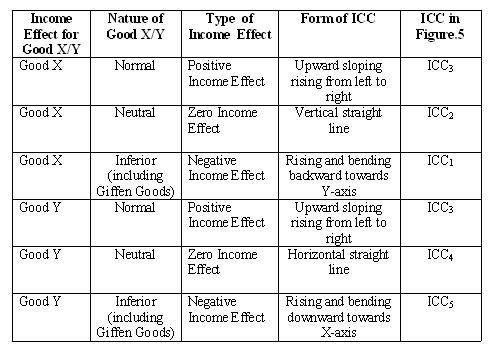INDIFFERENCE CURVES: INCOME EFFECT
MICROECONOMICS

|
INCOME EFFECT |

|
Introduction |
In the previous section on price effect we have discussed how a consumer rearranges her/his optimal consumption combination, to once again maximize utility of her/his spendable income, as a response to change in price of a good. We have also seen consumer's responses to a price change in case of different types of goods.
| Income Effect |
In this section we are going to study income effect. In other words, understand how the optimal consumption combination changes as a result of change in consumer's income. Prices of goods X (PX) and Y (PY)remaining unchanged.
An income effect represents change in consumer’s optimal consumption combination on account of change in her/his income and thereby changes in her/his quantity purchased, prices of goods X (PX) and Y (PY)remaining unchanged. The consumer is better-off when optimal consumption combination is located on a higher indifference curve and vice versa.
Understand that like price effect, a consumer's responses to income changes also differ depending upon the nature of the good, viz. a normal good, inferior good or a neutral good. These are summarized in chart.1:
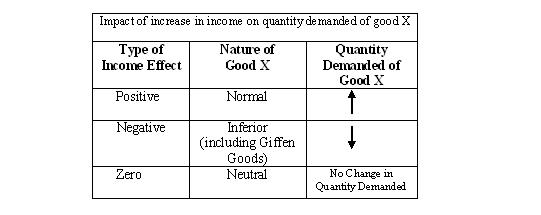
Thus, an income effect is positive in case of normal goods. There is direct relationship between income and quantity demanded. It is negative in case of inferior goods (including Giffen goods) where we find inverse relationship between income and quantity demanded. Finally, income effect is zero in case of neutral goods where consumer's quantity demanded is fixed.
Positive, negative and zero price effects are discussed with the help of indifference curves in the following subsections.
| Positive Income Effect |
In this section we are going to study how the optimal consumption combination changes as a result of change in consumer's income. Goods X and Y are normal goods. Prices of goods X (PX)and Y (PY) remaining unchanged. Figure.1 starts with the initial optimal consumption combination attained at point e at which OX units of good X and OY units of good Y are purchased.
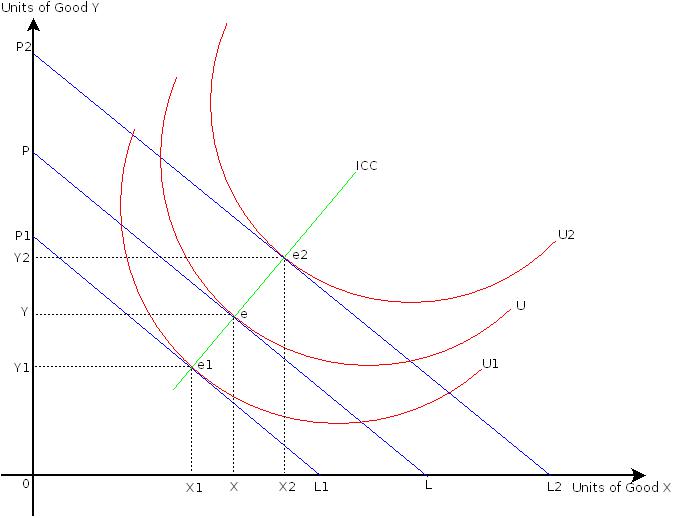
Whenever income of the consumer change, the entire budget constraint shifts outwards or inwards. With decrease in income the entire budget constraint shifts inwards and it is a parallel shift. Similarly, when income increases then entire budget constraint shifts outwards and it is a parallel shift. This is shown by budget constraint P2L2 in Figure.1.
When consumer's income decreases, the budget constraint moves inwards. This is shown by budget constraint P1L1 in Figure.1. The optimal consumption is located at point e1 at which the consumer buys OX1 units of good X and OY1 units of good Y . Consumer’s total utility decreases as the optimal consumption combination is located on a lower indifference curve U1.
Similarly, when consumer's income increases, the budget constraint moves outwards. This is shown by budget constraint P2L2. The optimal consumption is now located at point e2, at which the consumer buys OX2 units of good X and OY2 units of good Y. Consumer’s total utility increases as the optimal consumption combination is now located on a higher indifference curve U2.
Chart.2 presents a summary of Figure.1.
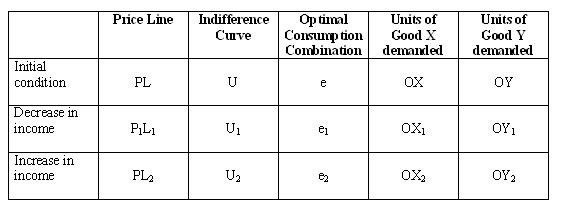
The curve obtained by joining optimal consumption combinations such as e1, e and e2 is called the income consumption curve (ICC). The ICC in Figure.1 is rising upwards to the right. It shows that the consumer successively moves on a higher indifference curve and becomes better off, with increase in her/his income and she/he also increases consumption of of goods X and Y. Here income effect is positive for goods X and Y.
| Negative Income Effect |
We now study negative income effect. Good X is an inferior good and good Y is a normal good. You will now understand how consumer's optimal consumption combination changes as a result of change in her/his income. Prices of goods X (PX)and Y (PY)remaining unchanged. Figure.2 starts with the initial optimal consumption combination attained at point e at which OX units of good X and OY units of good Y are purchased.
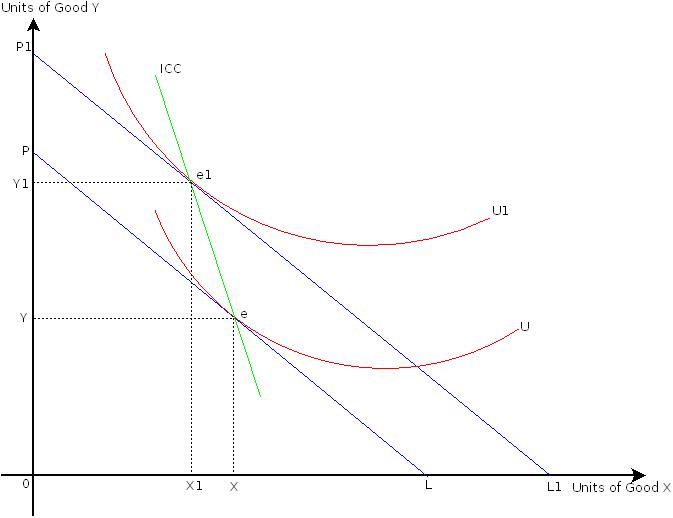
When income of the consumer increases, then entire budget constraint shifts outwards and it is a parallel shift. This is shown by budget constraint P1L1. The optimal consumption is now located at point e1, at which the consumer now buys OX1 units of good X and OY1 units of good Y.
Understand that consumer’s total utility has increased as the optimal consumption point is now located on a higher indifference curve. The consumer is better-off in terms of total utility. However, she/he reduces consumption of good X to OX1 units as good X is an inferior good. As mentioned in chart.1 we observe inverse relationship between income and quantity demanded of good X.The consumer increases quantity demanded of good Y as good Y is a normal good. Here income effect is negative for good X.
Chart.3 presents a summary of Figure.2.
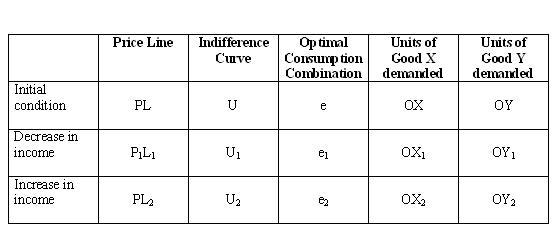
The ICC obtained by joining optimal consumption combinations such as e, and e1, in Figure.2 rises upwards but bending backwards. It shows that the consumer successively moves on a higher indifference curve and becomes better off, with increase in her/his income. however, she/he also reduces purchase of good X as it is an inferior good.
| Zero Income Effect |
We now study zero income effect. Good X is a neutral good and good Y is a normal good. You can now see how consumer's optimal consumption combination changes as a result of change in her/his income. Prices of goods X PX)and Y (PY) remaining unchanged. Figure.3 starts with the initial optimal consumption combination attained at point e at which OX units of good X and OY units of good Y are purchased.
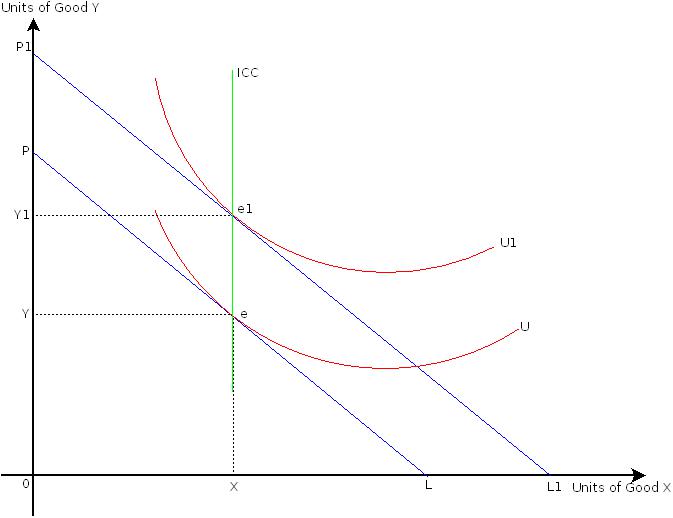
When consumer's income increases, then entire budget constraint shifts outwards and it is a parallel shift. This is shown by budget constraint P1L1. The optimal consumption is now located at point e1, at which the consumer now buys same OX units of good X and OY1 units of good Y.
Understand that consumer’s total utility has increased as the optimal consumption point is now located on a higher indifference curve U1. The consumer is better-off in terms of total utility. However, she/he keeps consumption of good X fixed at OX units as good X is a neutral good. As mentioned in chart.1 we observe no change in quantity demanded of good X.The consumer increases quantity demanded of good Y as good Y is a normal good. Here income effect is zero for good X.
Chart.4 presents a summary of Figure.3.

The ICC obtained by joining optimal consumption combinations such as e, and e1, in Figure.3 is a vertical straight line. It shows that the consumer successively moves on a higher indifference curve and becomes better off, with increase in her/his income. However, she/he is keeping purchase of good X fixed as it is a neutral good. The consumer increases quantity demanded of good Y as it is a normal good.
| Forms of Income Consumption Curve |
In the above discussion on positive, negative and zero income effects we have considered good X to be normal good, inferior good and neutral good respectively. Similarly, we can explain income effect for different types of good Y. Figure.4 shows different forms of ICC for different natures of good X or good Y.
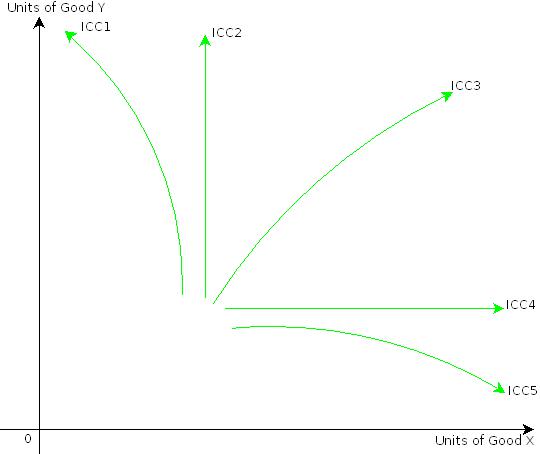
ICC1 is rising upwards and bending towards Y-axis. This form of ICC is obtained when good X is an inferior good (including Giffen goods). The ICC is a vertical straight line as shown by ICC2 when good X is a neutral good. It is a rising curve from left to right as shown by ICC3 when goods X and Y are normal goods.The ICC is a horizontal straight line as shown by ICC4 when good Y is a neutral good. Finally, ICC5 is rising upwards bending towards X-axis. This form of ICC is obtained when good Y is an inferior good (including Giffen goods). Chart.5 presents a summary of Figure.4.
